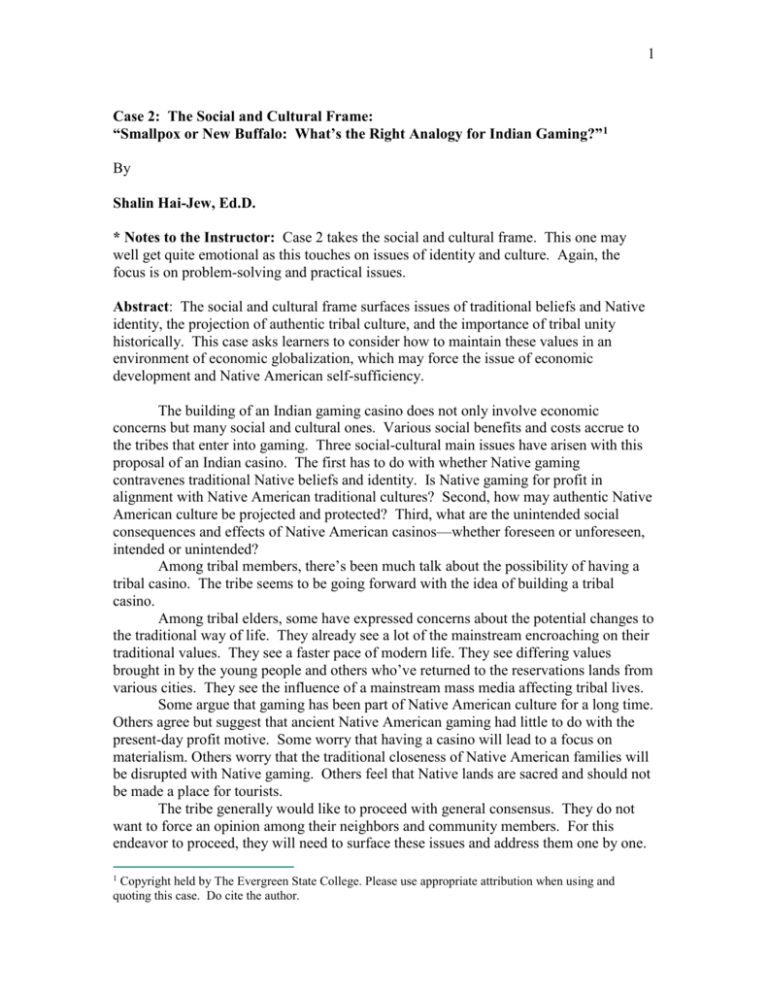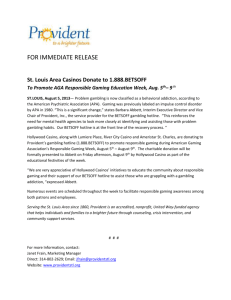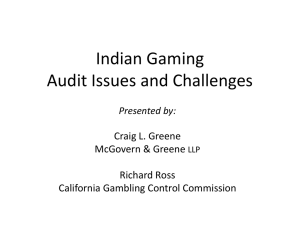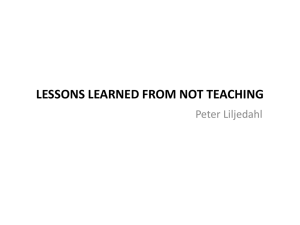* Notes to the Instructor: Case 2 takes the social and cultural frame
advertisement

1 Case 2: The Social and Cultural Frame: “Smallpox or New Buffalo: What’s the Right Analogy for Indian Gaming?” 1 By Shalin Hai-Jew, Ed.D. * Notes to the Instructor: Case 2 takes the social and cultural frame. This one may well get quite emotional as this touches on issues of identity and culture. Again, the focus is on problem-solving and practical issues. Abstract: The social and cultural frame surfaces issues of traditional beliefs and Native identity, the projection of authentic tribal culture, and the importance of tribal unity historically. This case asks learners to consider how to maintain these values in an environment of economic globalization, which may force the issue of economic development and Native American self-sufficiency. The building of an Indian gaming casino does not only involve economic concerns but many social and cultural ones. Various social benefits and costs accrue to the tribes that enter into gaming. Three social-cultural main issues have arisen with this proposal of an Indian casino. The first has to do with whether Native gaming contravenes traditional Native beliefs and identity. Is Native gaming for profit in alignment with Native American traditional cultures? Second, how may authentic Native American culture be projected and protected? Third, what are the unintended social consequences and effects of Native American casinos—whether foreseen or unforeseen, intended or unintended? Among tribal members, there’s been much talk about the possibility of having a tribal casino. The tribe seems to be going forward with the idea of building a tribal casino. Among tribal elders, some have expressed concerns about the potential changes to the traditional way of life. They already see a lot of the mainstream encroaching on their traditional values. They see a faster pace of modern life. They see differing values brought in by the young people and others who’ve returned to the reservations lands from various cities. They see the influence of a mainstream mass media affecting tribal lives. Some argue that gaming has been part of Native American culture for a long time. Others agree but suggest that ancient Native American gaming had little to do with the present-day profit motive. Some worry that having a casino will lead to a focus on materialism. Others worry that the traditional closeness of Native American families will be disrupted with Native gaming. Others feel that Native lands are sacred and should not be made a place for tourists. The tribe generally would like to proceed with general consensus. They do not want to force an opinion among their neighbors and community members. For this endeavor to proceed, they will need to surface these issues and address them one by one. 1 Copyright held by The Evergreen State College. Please use appropriate attribution when using and quoting this case. Do cite the author. 2 I. Traditional Beliefs and Native Identity First, some members of the tribe want to see how a casino may affect their traditional beliefs. These include valuing the land and protecting natural resources, not encouraging games of chance that lead to monetary loss, and mixing religious and spiritual approaches to gaming with commercial ones. Gambling: A Part of North American Native Culture. Gaming is not a recent invention of modern Native Americans. It has been traced back historically, but its purpose and use differed than in its current use. “Gambling is a part of many traditional North American tribal cultures. Historically, tribes have used games as a means of redistributing wealth and circulating possessions within a community. Tribal games of chance included games similar to dice and shell games; games of dexterity including archery, ball games, races, and ‘hoop and pole.’ All games could be wagered on. Typically, such games were tied to religious beliefs and sacred rituals, and the gambler is a figure that appears throughout Native legend and mythology” (Light and Rand, 2005, p. 39). Some traditional games have continued through the present. “Gambling, in a variety of forms, has long been an important part of American Indian culture and tradition. One ancient game called ‘stick game’ among northwest tribes has variations among most tribes and is still played at tribal gathering. Horse and foot races were an important focus of traditional gambling activity” (Nash, n.d., n.p.). “Profit as a primary motive for gaming is a more modern concept” (Light and Rand, 2005, p. 39). No “Monolithic” Native American “Culture” but Numerous Cultures. The role of traditional North American Native beliefs regarding the issue of gaming may not be so easy to decipher. There’s a wide range of differing cultural backgrounds and diversity among Native Americans. “At the time of first European contact with native peoples in North America, there were approximately 1,000 different tribes, representing a huge array of languages and numerous sub-dialects. Each of these tribes had its own religious practices, social structures, governmental organization, gender division, dress, customs, and rituals. Today, this number has declined to approximately 511 culturally distinct, federally recognized tribes and about an additional 200 unrecognized tribes. And of these remaining tribes, the populations of each have dramatically declined from the time of colonialization through disease and oppression over the past 300 years” (Darian-Smith, 2004, p. 18). Which groups may be viewed as federally recognized Native American tribes requires intensive scrutiny by the U.S. government. Authenticity, Indian Identity and “Paper Tribes”. Federal legal recognition comes with rights, responsibilities and privileges, and as such, the oversight agency invests much attention into a tribe’s history, cultural elements, language, and other aspects for the authentication process. The federal government requires a number of proofs before they will recognize a Native tribe as authentic. Different tribes themselves have requirements for enrolling members—with some require blood quantum, documentation, and proofs of lineal descent (Darian-Smith, 2004, p. 12). In contrast to these requirements, there is the counter-assertion that Native Americans need to decide 3 for themselves who they are (Castile, Dec. 1996, pp. 743 – 749). “’Reorganization’ added complexities to the rules of blood and shifted more responsibility for sorting them out to the tribes themselves, as it did in other areas of newly gained self-governance.” (Castile, 1992, p. 744) “Who is to say who is real and who invented, since after all, every people ‘plays’ with its history in an ongoing process of self-invention” (Dietler 1994; Lofgren 1995, as cited by Castile, 1992, p. 747)? Mezey suggests that the concepts of the pan Indian makes them not fully real, and the dominant culture’s sense of the “Indian” with all its fakeness has been retained and authenticated (p. 726). In a context of cultural relativism without any standard of authenticity to begin with, on what basis may the “real” be established? This author describes the traditional view of culture based on linguistic traditions, pre-contact practices and social structures, religious traditions, and nonmaterialistic and classless societal values (Mezey, Feb. 1996, p. 728). “The traditionalists may not survive the economic difficulties inherent in maintaining a traditional culture amidst evermodernizing influences” (Mezey, Feb. 1996, p. 730). What exists seems to be a “negotiation model” in which individuals make tradeoffs and co-create identity, according to Mezey (p. 734). Other thinkers do not subscribe to this view of modernists vs. traditionalists. “Again, the primary conflict is not between modern and traditional forces on the reservation but rather, how they feed and fractionate historical differences that result from ‘administrative technologies’ of the BIA” (Bureau of Indian Affairs) (Biolsi, 1992, as cited by Fenelon, Nov. 2006, p. 389). Native Americans have been frustrated by the rigorous processes required for gaining federal recognition on the one hand and then the threat of imposters on the other. Regarding the latter concern, there’s the phenomena of individuals and groups asserting tribal authenticity without basis in fact. The National Congress of American Indians has made statements through the years against the “abhorrent practice” of imposters who are not federally or state recognized tribes (Johnson, Aug. 21, 2007, p. 1). Here, various tribes call on the Federal Bureau of Investigations (FBI) to discontinue such practices of people misrepresenting themselves as Native Americans without basis. II. Projecting and Protecting Authentic Native American Culture Still other tribal members want to protect the name and reputation of Indians of their tribe and pan-Indians as well. Avoiding the commercialization of the Indian identity has arisen as another point of concern, raised in the context of the branding of Native American casinos. “According to Wesaw, ‘The commercial use of Native American spiritual beliefs (has a) major impact on Native American cultures: these practices deny the very existence of traditional Native American beliefs as valid ways of life today. They do not foster acceptance of Native American lifestyles—they trivialize them’” (Wesaw, 1995, pp. 9 – 10, as cited by Darian-Smith, 2004, p. 32). On the other hand, there’s the need to fight against mistaken mainstream stereotypes of Native Americans. Anthropologist and former lawyer Darian-Smith argues that mainstream America does not want to accept the image of the “rich Indian” because of deeply embedded racial stereotypes. She found her students “certain that it is somehow ‘wrong’ for indigenous peoples to make money, drive SUVs, wear business 4 suits, send their children to expensive schools, and (in their opinion as opposed to reality), be granted legal exceptions to operate outside the law of the United States. Many of these students also believe that ‘rich Indians’ can no longer be authentic Indians, and that participating in capitalist ventures will diminish their cultural uniqueness” (DarianSmith, 2004, p. xi). In reality, Native gaming exists under tight legal and regulatory control from the federal levels on down, and many tribal casinos contribute much to build tribal unity and share their cultural richness. Misperceptions of who Native Americans are have affected US policies. “Among other things, tribes have been cast as for-profit corporations, ethnic groups with entitlements granted by Congress, or fraternal associations, and each of these misconceptions carries with it implications for crafting policy” (Cornell, Kalt, Krepps, and Taylor, July 31, 1998, p. 2). Mass Media Images of Native Americans and Gaming. Depictions of Native American gaming in mainstream media have revealed storylines that show mainstream misperceptions and over-generalizations “These story lines reveal both the place of Indian gaming at the forefront of popular discourse and the common fundamental misapprehension of tribal gaming. As the Malcolm in the Middle episode indicates, some Americans—at least those who write network sitcoms—seem to believe that any person of Native American heritage has the ‘right’ to open a casino. This, of course, could not be further from the truth. Only federally recognized tribal governments may open casinos and, for casino-style gaming, only after a protracted negotiation process with state government. Some tribal casino managers may, at times, don ceremonial dress—but none would likely do so in the workplace. Most tribal members are just as unrepresentative of Indian stereotypes as are most Italian Americans unlike Mafiosos. And, of course, Native Americans are not ‘red men,’ they do not seek to use Indian gaming as a form of vengeance against ‘the white man,’ and they are unable to simply buy and destroy a city. Yet, although easily discredited in academic circles, these and other misperceptions and overgeneralizations about tribal gaming exemplify themes that appear to reflect and influence both public opinion and public policy. As states, tribes, and the federal government struggle to regulate a booming industry within the complicated context of tribal sovereignty, Indian gaming raises highly significant questions of law and policy” (Light and Rand, 2005, p. 2). The “Exchange Value” of Culture. Some thinkers see the commodification (the packaging and selling) of Native American identity as having an exchange value. Here, the popular concept of Native Americans may be used for gaming and entertainment purposes, in a sense. “Gambling, in its most extravagant form, has become the next stage of postmodern consumption. Las Vegas casinos exemplify Baudrillard’s version of Marx’s last stage in the genealogy of market transformation, where abstractions like knowledge and culture acquire exchange value and become inextricable from the operations of buying and selling. That is, at the Luxor, representations of an ahistorical Egypt are not mere accessories to promote gambling, but are themselves market commodities. And these products sell. In 1992, Americans spent six times more on gambling than on movie tickets” (Mezey, Feb. 1996, p. 712). Trading away culture and intangibles for the material? In contrast, Young suggests that nonmaterial goods are not tradable—per se. “Iris Young, for example, acknowledges that social justice cannot be reduced to the allocation of wealth and the 5 distribution of other material goods, but insists that material and nonmaterial goods are incommensurate and that non-material goods must be removed from the distributive paradigm, because ‘the concept of distribution presents them as though they were static things instead of a function of social relations and processes.’ To apply the language of distribution to ‘social goods’ reifies as things those aspects of life (such as rights) that are only relational. “The problem with Young’s conceptualization, however, is that by demanding incommensurability between material and nonmaterial goods, she precludes asking the questions of when and under what circumstances material and nonmaterial goods appear comparable. An ideology (as opposed to a theory) of anticommensurability obscures the ways in which we nevertheless treat the most intimate aspects of life as material goods in some instances. In fact, culture and self-determination (which is akin to sovereignty), two of the nondistributive goods Young considers, are precisely the goods that appear to be distributed under some theories of gaming rights… “Gaming clearly shifts the allocation of wealth in particular instances, but it also vividly alters the balances of sovereignty and the production of cultural identity. The remainder of this note examines which of these ‘goods’ gaming most effectively distributes under what circumstances, how choices between material and nonmaterial goods are made, and when these choices are avoided by dismantling the distinction between material and nonmaterial goods. Yet how these questions are framed (and answered) differs depending on the cultural paradigm one adopts. After describing the history and substance of the law governing Indian gaming, I consider its distributive effects under three cultural paradigms: Postmodern, Traditional, and what I call Culture as Negotiation” (Mezey, Feb. 1996, p. 717). Mezey offers a categorically practical view. “Nostalgia for the past exists only as a commodity to be inventoried and accumulated” (Feb. 1996, p. 724). This author argues that Indian gaming-generated funds have created a revival of culture for at least one tribe. “Moreover, the Pequots have sought to turn profit into cultural tradition and identity. Money, if not commensurate with culture, has for the Pequots been commensurate with cultural production. The Foxwoods Casino boasts ‘wampum’ betting cards and cocktail waitresses in generically fringed and beaded tunics. The tribe has hired an archaeologist to uncover its history and to stock its new museum. In 1994, the tribe contributed $10 million to the Smithsonian museum for an American Indian building, that institution’s largest gift to date. But the Pequot’s cultural identity remains elusive and flexible.” (Mezey, Feb. 1996, p. 725) Some suggest that the Pequots have usurped their own culture for economic purposes. It is possible that in the same way the US attitudes have changed over time towards gaming that Native American peoples’ ideas may also evolve? While gambling has been a part of Native cultures for millennia, it was not practiced the way it is today—for profit. III. Social Change Effects Other detractors to Indian gaming suggest that social changes brought about by such gaming may be negative. They cite issues such as an increased sense of individualism over communalism; greater economic assimilation into mainstream 6 society, a focus on materialism over spiritualism, and competition between Native Americans and each other as some negative social change effects. The economic concept of the “hedonic treadmill” suggests that individuals adjust to improved material circumstances quickly and assume those benefits as givens. This approach goes against the Native American cultural value of gratefulness and humbleness. Unity among tribes. A third issue is that of protecting relationships between Native Americans. The infusion of moneys and the introduction of economic competitiveness has created a situation of “haves” and “have-nots”. The non-gaming tribes may feel left out of this endeavor. “Yet running a gaming operation is neither an individual enterprise, nor does it guarantee that the profits will be distributed to individuals according to need” (Mezey, Feb. 1996, p. 715). Researchers have found that there is a decrease in the sense of community with residents near Indian casinos as well. “Residents of places with gaming operations felt a decrease in their sense of community as well as a reduced overall quality of life (Carmichael, et al., 1996; Long, 1996; USGAO, 2000). Yet, residents appear to approve of these casino developments. Room, et al. (1999) found that even with increased criminal activity and problem gambling, the community approved (75%) of the casino after the first year. Giacopassi, et al. (1999) found similar results” (Janes and Collison, 2004, p. 17). People have asked what the various unintended consequences of Native gaming may be in a social-cultural sense. This part of the three-part case touches on some of the issues of concern. References Akiwenzie, C. (1996, Jan.) A modern ‘small-pox’ for Native culture. The Thinker. n.p. Anders, G.C. (1998, Mar.). Indian gaming: Financial and regulatory issues. Annals of the American Academy of Political and Social Science: Vol. 556, Gambling: Socioeconomic Impacts and Public Policy. pp. 98 – 108. Andrade, R. (2006, Nov.) True lies: Governor Schwarzenegger and other political leaders’ response to tribal issues. American Behavioral Scientist: Vol. 50, pp 410 – 419. Awe, S.C., Keating, K. and Schwartz, D.G. (2002). Studies in chance: A selective guide to gaming industry resources. Reference Services Review: Vol. 30, No. 2. pp. 169 – 175. Breen, H. and Hing, N. (2002). Improving competitiveness through cooperation: Assessing the benefits of cooperative educational partnerships in gaming management. UNLV Gaming Research & Review Journal: Vol. 6, Iss. 1, pp. 57 – 72. Castile, G.P. (1996, Dec.) The commodification of Indian identity. American Anthropologist, New Series, Vol. 98, No. 4, pp. 743- 479. Contreras, K. S. (2006, Nov.) Cultivating new opportunities: Tribal government gaming on the Pechanga Reservation. American Behavioral Scientist: Vol. 50, pp. 315 – 352. 7 Cornell, S. and Kalt, J.P. (n.d.) Sovereignty and nation-building: The development challenge in Indian Country today. pp. 1 – 35. Cornell, S. and Kalt, J.P. (n.d.) “Reloading the Dice: Improving the Chances for Economic Development on American Indian Reservations.” What can tribes do? Strategies and institutions in American Indian economic development. (Introductory Chapter.” American Indian Studies Center. pp. 1 – 51. Cornell, S., Kalt, J., Krepps, M. and Taylor, J. (1998, July 31). American Indian gaming policy and its socio-economic effects: A report to the National Gambling Impact Study Commission. Lexecon. pp. 1 – 78. Darian-Smith, E. (2004). New capitalists: Law, politics, and identity surrounding casino gaming on Native American land. Belmont: Thomson Wadsworth. pp. xi, 5, 6, 12, 17, 18, 32, 48, 50, 56 – 57, 96, 111 and 115) Davidson, A. (1993) Endangered peoples. San Francisco: Sierra Club Books. pp. ix, 2, 8, 10, and 11. Elinson, Z. (2007, Jan. 19). Indian tribes bet on big firms. Law.com. The Recorder. n.p. Fenelon, J. (2006, Nov.) Indian gaming: Traditional perspectives and cultural sovereignty. American Behavioral Scientist: Vol. 50, pp. 381 – 409. Fink, S. and Rork, J. (2003, Sept. 16). The importance of self-selection in casino cannibalization of state lotteries. Economics Bulletin: Vol. 8, No. 10, pp. 1 –8. Frey, J. H. (1998, Mar.) Federal involvement in U.S. gaming regulation. Annals of the American Academy of Political and Social Science: Vol. 556, Gambling: Socioeconomic Impacts and Public Policy. pp. 138 – 152. Furlong, E.J. (1998). A logistic regression model explaining recent state casino gaming adoptions. Policy Studies Journal: Vol. 26, No. 3. pp. 371 – 383. Galbraith, C.S. and Stiles, C.H. (2003, Aug.) Expectations of Indian reservation gaming: Entrepreneurial activity within a context of traditional land tenure and wealth acquisition. Journal of Developmental Entrepreneurship: Vol. 8, No. 2. pp. 93 – 111. Gaming tribe report. (2006, Sept. 25). National Indian Gaming Commission. pp. 1 – 40. Garrett, T.A. (2004, Jan. – Feb.) Casino gaming and local employment trends. Federal Reserve Bank of St. Louis Review: Vol. 86, No. 1, pp. 9 – 22. Golab, J. (2004, Sept.) The festering problem of Indian ‘sovereignty’. The American Enterprise: Vol. 15, Iss. 6. Research Library. pp. 26 – 31. Higley, J. (2006, July 18). Gaming and lodging: a pair of kissing cousins? Hotel & Motel Management. Checking In: Perspective and Letters. Questex Media Group. n.p. Indian Gaming: 2005 Economic Impact Report: An Analysis of the Economic Impact of Indian Gaming in 2005. (2006). pp. 1 – 32. Janes, P.L. and Collison, J. (2004). Community leader perceptions of the social and economic impacts of Indian gaming. UNLV Gaming Research & Review Journal: Vol. 8, Iss. 1. ABI / INFORM Global. pp. 13 – 30. Janisch, R.F. (2006, Nov.) Sovereignty, Indian gaming, and economic development on The Lake Traverse Reservation of the Sisseton-Wahpeton Sioux Tribe (Oyate). American Behavioral Scientist: Vol. 50, pp. 353 – 372. Johnson, J. (2007, Aug. 21). “Statement of Jacqueline Johnson, NCAI Executive 8 Director, Fraudulent group found impersonating Indian tribes.” National Congress of American Indians. pp. 1 – 2. Jorgensen, M. and Taylor, J. (n.d.) What determines Indian economic success? Evidence from tribal and individual Indian enterprises. The Harvard Project on American Indian Economic Development, Wiener Center for Social Policy, John F. Kennedy School of Government, Harvard University. pp. 1 – 14. Kelso, M. (1996, Jan.) A ‘golden’ gopher? The unfair gambling business in America’s Northland. pp. 1 – 2. Light, S.A. and Rand, K. R.L. (2005). Indian gaming and tribal sovereignty: The casino compromise. Lawrence: University Press of Kansas. pp. 1 – 240. MacDonald, A. (2002). Game volatility at baccarat. UNLV Gaming Research & Review Journal: Vol. 6, Iss. 1, pp. 73 – 77. McConnell, C.R. and Brue, S.L. (2002).. Economics: Principles, Problems, and Policies. 15th Edition. Boston: McGraw-Hill Irwin. McGuire, K. (2006, July 11). National Indian Gaming Association releases report on the economic impact of Indian gaming in 2005. National Indian Gaming Association. Press release. pp. 1 – 2. Meister, A. (2006, Nov. 17). 2006 Indian gaming report. International Gaming & Wagering Business. pp. 34 – 35. Mezey, N. (1996, Feb.) The distribution of wealth, sovereignty, and culture through Indian gaming. Stanford Law Review: vol. 48, No. 3. pp. 711 – 737. Nash, D.R. (n.d.) Indian gaming. University of Idaho School of Law, Staff Access. n.p. National Indian Gaming Association: Presentation of Survey Results. (2006, July). Fairbank, Maslin, Maullin & Associates. Report 320-290. n.p. Nykiel, R.A. (2004). A special look at Indian gaming. UNLV Gaming Research & Review Journal: Vol. 8, Iss. 2. ABI / INFORM Global, pp. 51 – 56. Pfaffenberg, C.J. and Costello, C. (2002). UNLV Gaming Research & Review Journal: Vol. 6, Iss. 1. pp. 33 – 41. Popp, A.V. and Stehwien, C. (2002, July). Indian casino gambling and state revenue: Some further evidence. Public Finance Review: Vol. 30, No. 4, pp. 320 – 330. Rephann, T. J., Dalton, M., Stair, A., and Isserman, A. (n.d.) Casino gambling as an economic development strategy. pp. 1 – 24. Sanchez, T. (1996). Everyone wins with Indian gaming. The Thinker. n.p. Siegel, D. and Anders, G. (2001, Mar.). The impact of Indian casinos on state lotteries: A case study of Arizona. Public Finance Review: Vol. 29, No. 2. pp. 139 – 147. Steinman, E. (2006, Nov.) (Mixed) perceptions of tribal nations’ status: Implications for Indian gaming. American Behavioral Scientist: Vol. 50, pp. 296 – 314. Stone, D. (2002, 1997, 1988). Policy paradox: The art of political decision making. New York: W.W. Norton & Company. Thalheimer, R. and Ali, M.M. (2003). The demand for casino gambling. Applied Economics: Vol. 35. pp. 907 – 918. Titz, K., Andrus, D., and Miller, J. (2002). Hedonistic differences between mechanical game players and table game players: An exploratory investigation on the road to a comprehensive theory for gambling. UNLV Gaming Research & Review Journal: Vol. 6, Iss. 2. pp. 23 – 32. Wackler, R.F. (2006, Nov.) Michigan gambling: The interactions of Native American, 9 Detroit, and Canadian casinos. American Behavioral Scientist: Vol. 50, pp. 373 - 380. Waddoups, C.J. (2002). Wages in Las Vegas and Reno: How much difference do unions make in the hotel, gaming, and recreation industry? UNLV Gaming Research & Review Journal: Vol. 6, Iss. 1, pp. 7 – 21. Wang, Z. and Aquino, H. (2002). Casino technology: Player tracking and slot accounting systems. UNLV Gaming Research & Review Journal: Vol. 6, Iss. 1. pp. 43 – 56. Weimer, D.L. and Vining, A.R. (1989, 1992, 1999). Policy Analysis Concepts and Practice. Third Edition. Upper Saddle River: Prentice-Hall, Inc. 59. Wetzel, C. (2006, Nov.) Intratribal contention concerning Indian gaming: Implications for syncretic tribalism. American Behavioral Scientist: Vol. 50, pp. 283 – 295.







